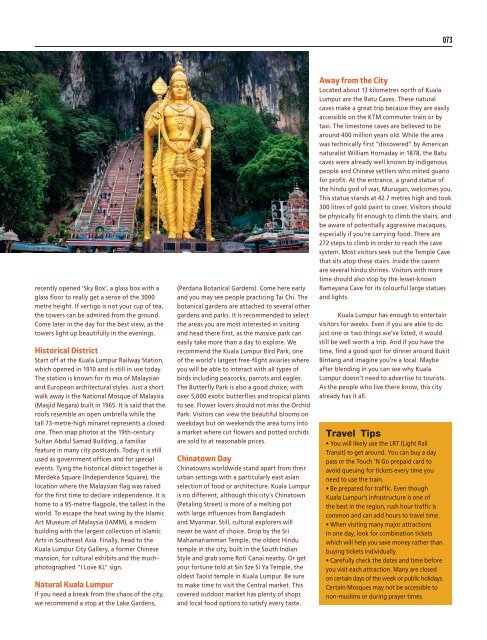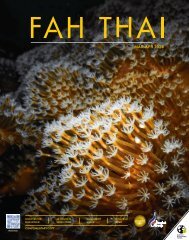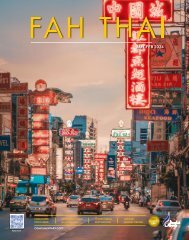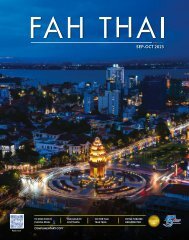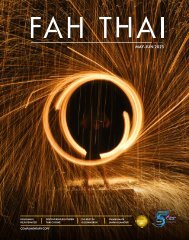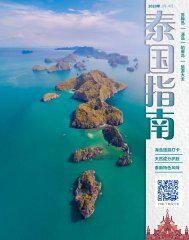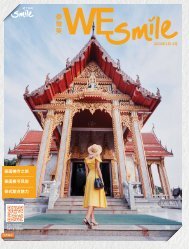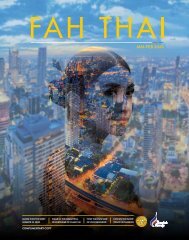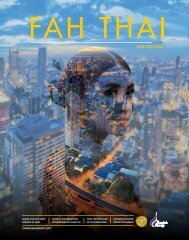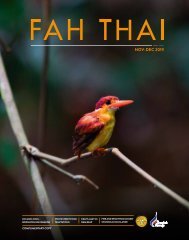WE Smile Magazine June 2017
The In-Flight Magazine of Thai Smile Airways
The In-Flight Magazine of Thai Smile Airways
Create successful ePaper yourself
Turn your PDF publications into a flip-book with our unique Google optimized e-Paper software.
073<br />
recently opened ‘Sky Box’, a glass box with a<br />
glass floor to really get a sense of the 3000<br />
metre height. If vertigo is not your cup of tea,<br />
the towers can be admired from the ground.<br />
Come later in the day for the best view, as the<br />
towers light up beautifully in the evenings.<br />
Historical District<br />
Start off at the Kuala Lumpur Railway Station,<br />
which opened in 1910 and is still in use today.<br />
The station is known for its mix of Malaysian<br />
and European architectural styles. Just a short<br />
walk away is the National Mosque of Malaysia<br />
(Masjid Negara) built in 1965. It is said that the<br />
roofs resemble an open umbrella while the<br />
tall 73-metre-high minaret represents a closed<br />
one. Then snap photos at the 19th-century<br />
Sultan Abdul Samad Building, a familiar<br />
feature in many city postcards. Today it is still<br />
used as government offices and for special<br />
events. Tying the historical district together is<br />
Merdeka Square (Independence Square), the<br />
location where the Malaysian flag was raised<br />
for the first time to declare independence. It is<br />
home to a 95-metre flagpole, the tallest in the<br />
world. To escape the heat swing by the Islamic<br />
Art Museum of Malaysia (IAMM), a modern<br />
building with the largest collection of Islamic<br />
Arts in Southeast Asia. Finally, head to the<br />
Kuala Lumpur City Gallery, a former Chinese<br />
mansion, for cultural exhibits and the muchphotographed<br />
“I Love KL” sign.<br />
Natural Kuala Lumpur<br />
If you need a break from the chaos of the city,<br />
we recommend a stop at the Lake Gardens,<br />
(Perdana Botanical Gardens). Come here early<br />
and you may see people practicing Tai Chi. The<br />
botanical gardens are attached to several other<br />
gardens and parks. It is recommended to select<br />
the areas you are most interested in visiting<br />
and head there first, as the massive park can<br />
easily take more than a day to explore. We<br />
recommend the Kuala Lumpur Bird Park, one<br />
of the world’s largest free-flight aviaries where<br />
you will be able to interact with all types of<br />
birds including peacocks, parrots and eagles.<br />
The Butterfly Park is also a good choice, with<br />
over 5,000 exotic butterflies and tropical plants<br />
to see. Flower lovers should not miss the Orchid<br />
Park. Visitors can view the beautiful blooms on<br />
weekdays but on weekends the area turns into<br />
a market where cut flowers and potted orchids<br />
are sold to at reasonable prices.<br />
Chinatown Day<br />
Chinatowns worldwide stand apart from their<br />
urban settings with a particularly east asian<br />
selection of food or architecture. Kuala Lumpur<br />
is no different, although this city’s Chinatown<br />
(Petaling Street) is more of a melting pot<br />
with large influences from Bangladesh<br />
and Myanmar. Still, cultural explorers will<br />
never be want of choice. Drop by the Sri<br />
Mahamariamman Temple, the oldest Hindu<br />
temple in the city, built in the South Indian<br />
Style and grab some Roti Canai nearby. Or get<br />
your fortune told at Sin Sze Si Ya Temple, the<br />
oldest Taoist temple in Kuala Lumpur. Be sure<br />
to make time to visit the Central market. This<br />
covered outdoor market has plenty of shops<br />
and local food options to satisfy every taste.<br />
Away from the City<br />
Located about 13 kilometres north of Kuala<br />
Lumpur are the Batu Caves. These natural<br />
caves make a great trip because they are easily<br />
accessible on the KTM commuter train or by<br />
taxi. The limestone caves are believed to be<br />
around 400 million years old. While the area<br />
was technically first “discovered” by American<br />
naturalist William Hornaday in 1878, the Batu<br />
caves were already well known by indigenous<br />
people and Chinese settlers who mined guano<br />
for profit. At the entrance, a grand statue of<br />
the hindu god of war, Murugan, welcomes you.<br />
This statue stands at 42.7 metres high and took<br />
300 litres of gold paint to cover. Visitors should<br />
be physically fit enough to climb the stairs, and<br />
be aware of potentially aggressive macaques,<br />
especially if you’re carrying food. There are<br />
272 steps to climb in order to reach the cave<br />
system. Most visitors seek out the Temple Cave<br />
that sits atop these stairs. Inside the cavern<br />
are several hindu shrines. Visitors with more<br />
time should also stop by the lesser-known<br />
Ramayana Cave for its colourful large statues<br />
and lights.<br />
Kuala Lumpur has enough to entertain<br />
visitors for weeks. Even if you are able to do<br />
just one or two things we’ve listed, it would<br />
still be well worth a trip. And if you have the<br />
time, find a good spot for dinner around Bukit<br />
Bintang and imagine you’re a local. Maybe<br />
after blending in you can see why Kuala<br />
Lumpur doesn’t need to advertise to tourists.<br />
As the people who live there know, this city<br />
already has it all.<br />
Travel Tips<br />
• You will likely use the LRT (Light Rail<br />
Transit) to get around. You can buy a day<br />
pass or the Touch ‘N Go prepaid card to<br />
avoid queuing for tickets every time you<br />
need to use the train.<br />
• Be prepared for traffic. Even though<br />
Kuala Lumpur’s infrastructure is one of<br />
the best in the region, rush hour traffic is<br />
common and can add hours to travel time.<br />
• When visiting many major attractions<br />
in one day, look for combination tickets<br />
which will help you save money rather than<br />
buying tickets individually.<br />
• Carefully check the dates and time before<br />
you visit each attraction. Many are closed<br />
on certain days of the week or public holidays.<br />
Certain Mosques may not be accessible to<br />
non-muslims or during prayer times.


